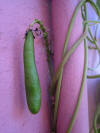WILD
FOODIES' HOME PAGE
PLANT PROFILE LIST
NAME: American Groundnut
SPECIES / FAMILY: Apios Americana / Fabaceae
OTHER COMMON NAME(S): Indian potato, hopniss
CONDITIONS: wet
and wooded areas
|
PARTS: |
EDIBLE |
TASTE |
RAW/COOK |
SEASON |
|
All |
|
|
|
|
|
Shoots |
|
|
COOK |
Spring |
|
Leaves |
||||
|
Stalk/Stem |
|
|
|
|
|
Buds |
||||
|
Flowers |
|
|
COOK |
Spring |
|
Fruits |
|
|
|
|
|
Pods |
|
|
COOK |
Summer |
|
Seeds |
|
|
COOK |
Summer |
|
Nuts |
|
|
|
|
|
Roots |
|
potato/nutty |
COOK |
Fall best |
|
Bark |
|
|
|
|
PORTION: medium
COMMENT: Seedpod looks like a green bean. Delicious roots. “They can be dug any time of year, and are usually just under the surface... They’re like beads on a string except they are larger and farther spread out. The “string” can also branch off. To find them I look for the vine climbing bushes and trees. It’s thin, about an eight of an inch through, covered with fine hair, and tough for its size… Groundnuts have a bitter latex in them and should be cooked first. They also have some “anti-nutrition factors” including protease inhibitors which cooking neutralizes… Groundnuts can be pea size to baseball size, smooth or lumpy. Most of the ones I find look like dark brown lumpy eggs. First year groundnuts are light yellow to reddish brown, and small. Second year, larger, darker, coarser. All are edible and peel like a tough potato.”(2)
CAUTION: Always go slow with any plant in case you are allergic or sensitive to it. // Some people have a bad reaction to the groundnut, causing them to lose fluids from both ends. I suspect that comes from under cooking the latex or an allergy. …. some people have eaten groundnuts for years with no problem and then have a reaction to it. It is not common but it does happen. A few, perhaps five percent, have an immediate reaction to it. Whether it is an allergy or the way the groundnut is grown is not known. So, be careful.(2)
NUTRITION/MEDICINAL: Groundnut also contains genistein, a known anti-carcinogenic compound. The Indians made a plaster out of it (cooked) for external cancers.(2) Tubers contain 17% crude protein, this is more than 3 times that found in potatoes. The tubers can be harvested in their first year but they take 2 - 3 years to become a sizeable crop. (1)
LOOK-A-LIKES:
POISONOUS LOOK-A-LIKES:
OTHER USES: Latex. There is one report that the plant contains a latex which could be used in the production of rubber.(1)
SOURCE LINKS:
- https://pfaf.org/user/plant.aspx?latinname=Apios+americana & https://pfaf.org/user/cmspage.aspx?pageid=54
- http://www.eattheweeds.com/groundnuts-anti-cancer-treat/
- https://en.wikipedia.org/wiki/Apios_americana
- http://www.foragingtexas.com/2009/09/groundnut.html (good photos)
- https://commons.wikimedia.org/wiki/Apios_americana
- http://tcpermaculture.blogspot.com/2012/03/permaculture-plants-groundnut.html
- https://savvygardening.com/growing-american-groundnuts
- https://honest-food.net/harvesting-eating-american-groundnuts

_tuber_small.jpg)


